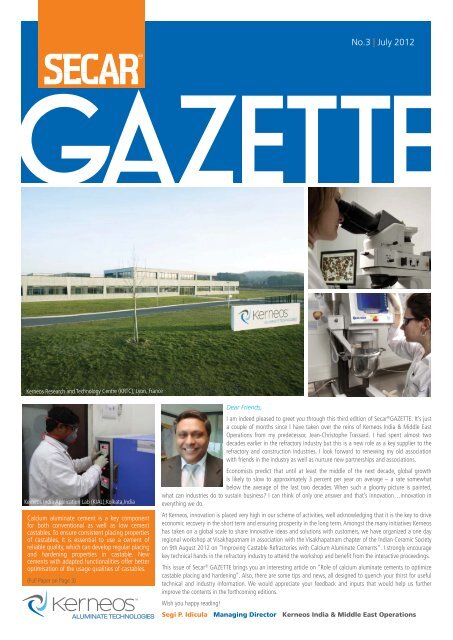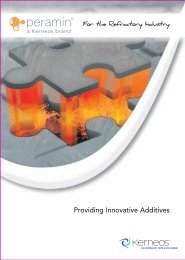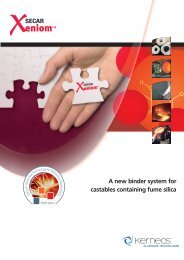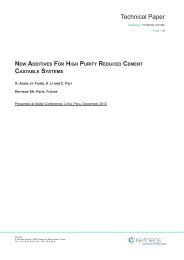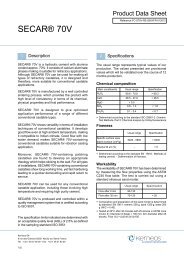News Latter VOL_3.indd - SECAR®, solutions for refractories
News Latter VOL_3.indd - SECAR®, solutions for refractories
News Latter VOL_3.indd - SECAR®, solutions for refractories
You also want an ePaper? Increase the reach of your titles
YUMPU automatically turns print PDFs into web optimized ePapers that Google loves.
No.3 | July 2012<br />
Kerneos Research and Technology Centre (KRTC), Lyon, France<br />
Kerneos India Application Lab (KIAL),Kolkata,India<br />
Calcium aluminate cement is a key component<br />
<strong>for</strong> both conventional as well as low cement<br />
castables. To ensure consistent placing properties<br />
of castables, it is essential to use a cement of<br />
reliable quality, which can develop regular placing<br />
and hardening properties in castable. New<br />
cements with adapted functionalities offer better<br />
optimisation of the usage qualities of castables.<br />
(Full Paper on Page 3)<br />
Dear Friends,<br />
I am indeed pleased to greet you through this third edition of Secar ® GAZETTE. It’s just<br />
a couple of months since I have taken over the reins of Kerneos India & Middle East<br />
Operations from my predecessor, Jean-Christophe Trassard. I had spent almost two<br />
decades earlier in the refractory industry but this is a new role as a key supplier to the<br />
refractory and construction industries. I look <strong>for</strong>ward to renewing my old association<br />
with friends in the industry as well as nurture new partnerships and associations.<br />
Economists predict that until at least the middle of the next decade, global growth<br />
is likely to slow to approximately 3 percent per year on average – a rate somewhat<br />
below the average of the last two decades. When such a gloomy picture is painted,<br />
what can industries do to sustain business? I can think of only one answer and that’s innovation…innovation in<br />
everything we do.<br />
At Kerneos, innovation is placed very high in our scheme of activities, well acknowledging that it is the key to drive<br />
economic recovery in the short term and ensuring prosperity in the long term. Amongst the many initiatives Kerneos<br />
has taken on a global scale to share innovative ideas and <strong>solutions</strong> with customers, we have organized a one day<br />
regional workshop at Visakhapatnam in association with the Visakhapatnam chapter of the Indian Ceramic Society<br />
on 9th August 2012 on “Improving Castable Refractories with Calcium Aluminate Cements”. I strongly encourage<br />
key technical hands in the refractory industry to attend the workshop and benefit from the interactive proceedings.<br />
This issue of Secar ® GAZETTE brings you an interesting article on “Role of calcium aluminate cements to optimize<br />
castable placing and hardening”. Also, there are some tips and news, all designed to quench your thirst <strong>for</strong> useful<br />
technical and industry in<strong>for</strong>mation. We would appreciate your feedback and inputs that would help us further<br />
improve the contents in the <strong>for</strong>thcoming editions.<br />
Wish you happy reading!<br />
Segi P. Idicula Managing Director Kerneos India & Middle East Operations
Market Pulse<br />
Tough Times Ahead <strong>for</strong> the Sponge Iron<br />
Industry<br />
The Sponge Iron industry is facing an<br />
acute shortage of its key raw material –<br />
iron ore.Coupled with this the stringent<br />
government policies and recession in<br />
the user steel industry are making <strong>for</strong> a<br />
bleak future <strong>for</strong> the industry in India.<br />
Concerns over environmental pollution,<br />
tough government policies as coal-based<br />
processes are highly energy intensive are<br />
other crucial factors accountable <strong>for</strong> the<br />
downslide. The global economic crisis is<br />
no less a contributor.<br />
The installed capacity of sponge iron in<br />
India is 35 millon tonnes while production<br />
is around 26 million tonnes. There are<br />
two process routes <strong>for</strong> manufacture, viz.<br />
through gas or non-coking coal. About<br />
45 per cent of the capacity is gas-based.<br />
The industry is made up of 300 small units<br />
and 10-15 large producers. Essar Steel,<br />
Jindal Steel and Power, JSW Ispat and<br />
Tata Sponge are the top four producers<br />
in India. The present crisis has led to an<br />
outage of capacity to the tune of 10%<br />
to 15%. India is the largest producer of<br />
sponge iron <strong>for</strong> the last nine consecutive<br />
years contributing to the economy in<br />
terms of taxes and employment. In the<br />
future too, sponge iron will continue to<br />
play an important role in steel making<br />
domestically.<br />
Natural gas has a limited availability<br />
in India, the price is regulated by the<br />
government and allocation is also<br />
restricted to each of the using sectors.<br />
The government is not able to meet the<br />
gas requirements of power companies,<br />
and sponge iron companies are low in<br />
priority. Hence, the tilt is towards coalbased<br />
plants <strong>for</strong> sponge iron companies.<br />
Proposed New National Steel Policy<br />
The new policy is likely to be finalised<br />
in about a couple of months, the Steel<br />
Secretary, Mr D.R.S. Chaudhary, told<br />
Steel Summit 2012, organised by the<br />
Confederation of Indian Industry. It would<br />
replace the National Steel Policy 2005.<br />
“The new policy will focus on removing<br />
infrastructure bottlenecks, improving<br />
technology and will focus on achieving a<br />
10 per cent growth. That’s the only way<br />
to grow. The more we expedite the new<br />
policy, the more beneficial it will be,” Mr<br />
Chaudhary said.<br />
Currently, the Indian steel sector is<br />
growing at a compounded growth of five<br />
per cent. Steel production is around 72<br />
million tonnes, broadly in line with the<br />
domestic demand. However, the demand<br />
is set to accelerate and touch 200 million<br />
tonnes by 2020.<br />
The Indian steel industry is at the cusp of a<br />
sustained high-growth phase. While low<br />
per capita consumption provides a huge<br />
market potential, the industry is faced<br />
with challenges such as resource scarcity,<br />
delay in clearances and land acquisition<br />
among others.<br />
Tech Edge<br />
<strong>SECAR®</strong>712 is a new generation 70% Al 2<br />
O 3<br />
cement and is the result of a novel process<br />
developed by Kerneos. It possesses all the<br />
attributes of <strong>SECAR®</strong>71 and more, a unique<br />
scientific breakthrough: time stable properties!<br />
As a result, SECAR ® 712 achieves new levels of<br />
castable per<strong>for</strong>mance:<br />
• Time stability counter balances a natural effect<br />
called ageing and enables stable properties of<br />
cement as well as castable over time. Stability<br />
of working time (both cement and castable) is<br />
observed even after 12 months storage.<br />
• Very low moisture pick-up is obtained in<br />
castables, especially beneficial in low cement<br />
systems.<br />
• Outstanding compressive strength stability (6<br />
hours) is observed even after 12 months.<br />
• SECAR ® 712’s shelf life is longer than 12<br />
months and properties retained <strong>for</strong> 24 months<br />
in simulated ageing.<br />
• SECAR ® 712 offers the same versatility<br />
as SECAR ® 71 and can be used in the<br />
same castable <strong>for</strong>mulations (CC, MCC,<br />
LCC, ULCC) swapping “one To one”<br />
with SECAR ® 71.<br />
KIAL, Kolkata, India<br />
Kerneos Corner<br />
Refractory Technical Campus at Lyon,<br />
France<br />
Kerneos organized a three day<br />
“Refractory Technical Campus” during<br />
10-12th July’12 at their “Research<br />
& Technology Centre” in Lyon,<br />
France. Prime objectives were to<br />
have better market and technological<br />
understanding of the environment<br />
in which Kerneos products are used<br />
especially in the context of steel plant<br />
applications, better dialogue with<br />
customers about their products and<br />
applications and the implications<br />
<strong>for</strong> calcium aluminate cements. All<br />
the market managers around the<br />
globe participated in the programme.<br />
Prasanta Dutta from Kerneos India took<br />
part in the programme to decode the<br />
customers’ need in the region.<br />
Workshop at Vizag<br />
Kerneos and the Indian Ceramic Society<br />
(ICS) Vizag would be conducting a one<br />
day workshop on improving castable<br />
<strong>refractories</strong> with calcium aluminate<br />
cement on August 9, 2012. With a<br />
participation of approx. 150 delegates<br />
the workshop will primarily benefit<br />
the small scale industries producing<br />
refractory castables in and around<br />
Vizag and Rajamundry.<br />
Kerneos is the world leader in calcium<br />
aluminate technology and a key supplier<br />
to <strong>refractories</strong>, steel and construction<br />
industry.”With state-of-the-art plants<br />
in almost all parts of the continent,<br />
Kerneos is expanding its activities in<br />
India with adaptable products <strong>for</strong> the<br />
country and production facilities” stated<br />
AK Tambe, Honorary Secretary of ICS<br />
Vizag Chapter.
ROLE OF CALCIUM ALUMINATE CEMENT TO OPTIMISE CASTABLE PLACING<br />
AND HARDENING<br />
INTRODUCTION<br />
Technical managers of many castable<br />
manufacturing companies have the<br />
experience of being called by the customers<br />
or their own marketing team complaining<br />
about too rapid or delayed setting. Often<br />
the installers take care of the quick<br />
stiffening or rapid flow decay with excess<br />
water addition severely compromising the<br />
final per<strong>for</strong>mance. For delayed setting<br />
the technical persons need to run to the<br />
installation site with packets of additives<br />
to face the disgruntled customer, who<br />
is then sceptical to meet his installation<br />
schedule. The optimisation of the placing<br />
and hardening properties is not easy<br />
considering several factors, such as effect<br />
of ambient temperature, quality of the<br />
matrix phase components, their interaction<br />
and aging of the mix. This article will discuss<br />
role of calcium aluminate cement, which a<br />
castable manufacturer often suspects first<br />
when he faces such a situation.<br />
Calcium Aluminate Phases And Reactivity:<br />
The mineralogy of a calcium aluminate<br />
cement determines its reactivity to a large<br />
extent. The cement does never consist of<br />
a single phase; rather it is a combination<br />
of several phases. The phase composition<br />
depends upon many parameters, although<br />
the chemistry may be considered the most<br />
important. The reactivity of the different<br />
phases is shown in the table 1 [1], which<br />
shows that the reactivity increases with the<br />
increase of lime %.<br />
Calcium monoaluminate (CA) is the<br />
most desirable phase, as it develops the<br />
highest strength among the phases during<br />
the short time available <strong>for</strong> hydration of<br />
refractory concrete. It takes time to initiate<br />
setting; however, it develops strength<br />
rapidly after initial set. It has a high melting<br />
point (1600°C). Calcium dialuminate<br />
(CA 2<br />
), although more refractory than<br />
CA, has slower reactivity, however, it can<br />
improve with increase in temperature.<br />
Calcium hexa aluminate (CA 6<br />
) is a non<br />
reactive phase and often it <strong>for</strong>ms as a<br />
reaction product in high purity alumina<br />
castable. Appropriate combination of the<br />
phases is essential to get desired reactivity.<br />
When Calcium Aluminate cements are<br />
placed in water they dissolve and <strong>for</strong>m<br />
ionic species. The relative ratio of C/A ions<br />
depends upon the starting mineralogy.<br />
The kinetics depend upon the ratio of C/A<br />
and the temperature.<br />
CA Ca 2+ + Al(OH) -<br />
4<br />
Table 1: The reactivity of the various calcium aluminate phases<br />
Nucleation and massive precipitation of Table 2: Hydration of calcium monoaluminate<br />
C= CaO, A= Al 2<br />
O 3<br />
hydrates continue following dissolution.<br />
The temperature and solubility of the<br />
Temperature Hydration Reaction<br />
hydrates determine the type of hydrate<br />
27°C 3CA + 12H C 3<br />
AH 6<br />
+ 2AH 3<br />
Importance of regularity:<br />
To get regular reactivity from a cement, which<br />
is essential to get the desired placing properties<br />
of castables, it is essential to have a consistent<br />
mineralogy of the cement. If the process<br />
of cement manufacturing is too variable<br />
to produce a reliable quality, the castable<br />
properties will vary making it impossible to<br />
control the placing and hardening properties<br />
Choice of calcium aluminate cement to<br />
optimise castable placing properties:<br />
One type of calcium aluminate<br />
cement is known to be used in several<br />
applications <strong>for</strong> long in India. However,<br />
the recent developments allow castable<br />
manufacturers benefit from adapted<br />
products, which are not only suitable <strong>for</strong><br />
specific climates, but also optimized <strong>for</strong><br />
the castable type, such as conventional<br />
or low cement. Examples are shown with<br />
adapted products such as Secar® 70V <strong>for</strong><br />
conventional castables and Secar® 68V<br />
<strong>for</strong> low cement castables with natural raw<br />
materials and silica fume.<br />
Usage qualities of conventional castables<br />
and Secar ® 70V:<br />
The usage qualities of conventional<br />
castables include long working time,<br />
yet rapid strength development, good<br />
mechanical strength, rheology compatible<br />
with common installation methods i.e.<br />
vibration casting, patching and gunning,<br />
stable placing properties even at high<br />
ambient temperatures. Secar ® 70V, an<br />
adapted cement <strong>for</strong> conventional castables<br />
addresses all these requirements. Figure 1<br />
shows that Secar ® 70V based 86% alumina<br />
conventional castable (table 3) develops<br />
good flow with lower water addition than<br />
other reference cements and retain some<br />
flowability after 60 minutes unlike other<br />
cements. Although Secar ® 70V-containing<br />
castables develop longer working time, it<br />
G. Bhattacharya*, B. Valdelièvre* and C. Parr.<br />
*Kerneos, Kolkata, India<br />
C 3<br />
A C 12<br />
A 7<br />
CA CA 2<br />
CA 6<br />
C/A 3 1.7 1 0.5 0.2<br />
Reactivity at 20°C Very rapid Fast Slow Very slow None<br />
F<br />
(temperature<br />
+ time)<br />
2CAH 10<br />
C 2<br />
AH 8<br />
+ AH 3<br />
+ 9H<br />
3C 2<br />
AH 8<br />
2C 3<br />
AH 6<br />
+ AH 3<br />
+ 9H<br />
develops strength rapidly (Figure 2). Not<br />
only at the ambient temperature, Secar ®<br />
70V based castables develop higher<br />
mechanical strength throughout the<br />
temperature range from 110°C to 1400°C<br />
(Figure 3).<br />
Table 3: Composition of 86% alumina<br />
conventional castable<br />
Raw materials Size Weight %<br />
Chinese Bauxite 1-5 mm 44<br />
Chinese Bauxite & BFA < 1 mm 35<br />
Calcined alumina 6<br />
Calcium aluminate cement 15<br />
Typical water% 9-10<br />
Vibration flow %<br />
140<br />
120<br />
100<br />
80<br />
60<br />
40<br />
20<br />
®<br />
Secar 70V_9,1% water<br />
B_10% water<br />
C_10.3% water<br />
0<br />
0 30 60<br />
Time mins<br />
Figure 1: Vibration flow as a function of time <strong>for</strong><br />
86% alumina conventional castable with Secar ®<br />
70V and other reference cements (B, C) at 35°C<br />
CCS 6h (MPa)<br />
20<br />
18<br />
16<br />
14<br />
12<br />
10<br />
8<br />
6<br />
4<br />
2<br />
0<br />
Secar ® 70V_9,1%<br />
Water<br />
B_10%<br />
Water<br />
C_10.3%<br />
Water<br />
Figure 2: CCS after 6h <strong>for</strong> 86% alumina castable<br />
with Secar ® 70V and other reference cements<br />
(B, C) 35°C
Compressive Strength MPa<br />
70<br />
60<br />
50<br />
40<br />
30<br />
20<br />
10<br />
0<br />
Secar 70V_9,1% water<br />
B_10% water<br />
C_10,3% water<br />
110°C 800°C 1100°C 1400°C<br />
Figure 3 : CCS as a function of temperature <strong>for</strong> 86%<br />
alumina castable with Secar ® 70V and other reference<br />
cements (B, C)<br />
Table 4: Composition of bauxite and silica fume based low cement<br />
castable<br />
Raw materials Size Weight %<br />
Chinese Bauxite 1-5 mm 50<br />
Chinese Bauxite & sillimanite < 1 mm 38<br />
Silica fume 6<br />
Secar ® 68V 6<br />
HMP 0.12<br />
Typical water% 4.5-5.5<br />
Usage qualities of low cement castables and Secar ® 68V:<br />
The low cement castables are more<br />
sensitive to water addition levels than<br />
conventional castables. High ambient<br />
temperature conditions, which prevail<br />
in most part of India <strong>for</strong> a major part<br />
of the year, pose a challenge to get<br />
sufficient flow <strong>for</strong> casting low cement<br />
castables with low water addition. Not<br />
only the development of flow, but also<br />
its retention is very important to complete<br />
the installation properly. There<strong>for</strong>e,<br />
the castables require functionality to<br />
stand the high temperature conditions<br />
to develop sufficient flowability and<br />
long working time <strong>for</strong> casting. Once the<br />
casting is complete, the castable needs<br />
rapid strength development, so that it<br />
can be demolded and heated up without<br />
any delay. Also, the castable requires<br />
good mechanical strength throughout<br />
the temperature range to meet various<br />
application requirements. Secar ® 68V is<br />
adapted to have these functionalities<br />
in low cement castables with natural<br />
aggregates and fume silica. It develops<br />
appreciable flow with low water addition<br />
even at high ambient temperature and<br />
retains <strong>for</strong> sufficiently long time <strong>for</strong><br />
casting (Figure 4) in common low cement<br />
castable <strong>for</strong>mulations (table 4). Despite,<br />
high flow <strong>for</strong> long time, the 6h strength<br />
is quite high which shows rapid strength<br />
development (Figure 5). Not only at the<br />
ambient temperature, Secar ® 68V based<br />
low cement castables develop high<br />
strength throughout a large temperature<br />
range (Figure 6).<br />
140<br />
70<br />
3.6<br />
210<br />
Vibration flow %<br />
120<br />
100<br />
80<br />
60<br />
40<br />
Water 5.2%<br />
20<br />
Exclusion zone<br />
Water 4.9%<br />
0<br />
0 20 40 60 80 100 120 140<br />
Time mins<br />
6hr Compressive Strength MPa<br />
60<br />
50<br />
40<br />
30<br />
20<br />
10<br />
0<br />
35.2<br />
22.8<br />
5.2%<br />
4.9%<br />
Water<br />
Water<br />
Water 5.2% Water 4.9%<br />
3.5<br />
3.4<br />
3.3<br />
3.2<br />
3.1<br />
3<br />
2.9<br />
6hr Modulus of Ruture MPa<br />
CCS : MPa<br />
180<br />
150<br />
120<br />
90<br />
60<br />
30<br />
Water 5.2%<br />
Water 4.9%<br />
0 400 800 1200 1600<br />
Temperature °C<br />
Figure 4: Vibration flow as a function<br />
of time <strong>for</strong> a bauxite based low cement<br />
castable with Secar ® 68V at 35°C with<br />
variation o f water addition<br />
Conclusion:<br />
Calcium aluminate cement is the<br />
most vital component of a castable.<br />
Its reactivity directly controls the key<br />
placing and hardening parameters,<br />
such as flow as a function of time and<br />
Figure 5: CCS and MOR after 6h <strong>for</strong> a bauxite<br />
based low cement castable with Secar ® 68V<br />
at 35°C with variation of water addition<br />
strength development. The consistency<br />
in reactivity can only be obtained with<br />
the use of very regular cement quality.<br />
However, the cement reactivity varies<br />
with temperature and the role of cement<br />
Figure 6: CCS as a function of temperature<br />
<strong>for</strong> a bauxite based low cement castable with<br />
Secar ® 68V with variation of water addition<br />
is different <strong>for</strong> conventional and low<br />
cement castables. The new cements with<br />
adapted functionalities take care of these<br />
requirements of castables in a better way.<br />
References:<br />
[1] C. Parr, “Calcium aluminate cement – what happens when things go wrong?”, presented at IRE<br />
annual conference, Rotherham, UK, 2008<br />
For more details mail : goutam.bhattacharya@kerneos.com<br />
Kolkata Office : KERNEOS INDIA<br />
3B – Shristi Bldg / 3rd Floor, 12, Ho Chi Minh Sarani, Kolkata 700 071, Tel: +91 33 3052 2315/16 Fax: +91 33 3052 2681<br />
Head Office : KERNEOS S.A<br />
8 Rue Des Graviers, 92521 Neuilly Sur Seine Cedex, France, Tel: +33 1 46 37 90 00 Fax: +33 1 46 37 92 00


